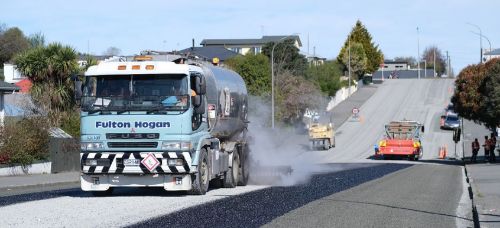27 Aug 2024
#INFRASTRUCTURE MATTERS
With the warmer weather fast approaching, our contractor, Fulton Hogan will soon begin to carry out the 2024/2025 Road Resurfacing Programme. This yearly, critical maintenance work is scheduled to begin in early September and typically lasts until March. Below is some helpful information about what we are doing and why it’s so important that we do it.
Residents and businesses of the affected streets will receive a flyer before work begins, which will include contact information for any inquiries to help ensure the community is kept in the loop.
What is Road Resurfacing?
Road resurfacing is the process of giving a road a fresh layer of material, typically a chip seal, to the existing road surface. It is often required when the road has become worn, cracked, or damaged due to factors such as traffic, weather, or aging. Road resurfacing is a critical part of road maintenance, helping to ensure our road network is in good condition and safe for road users.
Resealing the road surface is like putting a new coat of paint on your house, it makes it more waterproof and stops the old layer peeling/potholing which extends the life of the pavement beneath.
What is Chip Seal?
Remember when you were a kid, and you would do arts and crafts with glue and glitter? It's just like that! But instead of glue and glitter, the glue (bitumen emulsion) is sprayed down and then the chip (i.e. small stones) are rolled onto the surface binder instead.
What are the benefits of road resurfacing?
- Resurfacing the road addresses issues such as potholes and cracks in the road.
- Improves driver safety by improving the road traction for vehicles, reducing the risk of accidents.
- And ensuring the longevity of the infrastructure, by resurfacing a road, its overall lifespan is extended, delaying the need for more extensive and costly reconstruction.
What does this mean for you?
To ensure the safety of road users and the team working on site, roads that are receiving the resurfacing treatment will be closed to normal vehicular traffic while work is underway.
Good news! Since no excavation needs to be done for this work to take place, the road will only be closed for a limited amount of time. We do apologize for any inconvenience this may cause.
If your street/road is on the resurfacing program, you will receive a notice in your letterbox a week in advance to notify you. Our contractor will place "No Parking" signs on the street the day before to ensure the road is clear for the work to take place.
Pedestrian access will be maintained and the helpful team on site will guide you through.
What streets/roads are programmed?
* Please note that a road may not require resurfacing along its full length, we assess each road individually and programme resurfacing on the sections where it is needed.
| Ameer Street | Hassall Street | Melrose Street | Ribbonwood Road |
| Arowhenua Road | Hawkey Street | Mill Road | River Road |
| Beaconsfield Road | Heaton Street | Miro Street East | Salisbury Road |
| Bluestone Rise | High Street (Woodbury) | Miro Street West | Seadown Road |
| Brockley Road | John Street | Muff Road | Selwyn Street |
| Burke Street | Khan Street | Munro Street | Shere Street |
| Butlers Road | King Street (Temuka) | Newland Road | Spring Road |
| Cartwright Road | Lachlan Street | Nikau Street | St Leonards Road |
| Church Street | Levels Plain Road | North Boundary road | Stafford Street |
| Collingwood Street | Lindsay Street | Old Bridge road | Studholme Street |
| Davis Street | Livingstone Street | Opihi Road | Treneglos Street |
| Fraser Street (Temuka) | Macaulay Road | Ormsby Street North | Waikari Road |
| Frederick Street | MacDonald Street (Temuka) | Peel Street (Geraldine) | Washdyke Flat Road (Temuka) |
| Glamis Street | Mahoney's Hill Road | Pye Road (Geraldine) | White Street |
| Gully Bush Road | Maitland Street | Redwood Street | Wilson Street (Geraldine) |
| Harper Street | Matthew Road | Regent Street | Winchester-Hanging Rock Road |
Why isn't my street being done?
It’s all about ensuring the right road receives the right treatment at the right time. To ensure our limited maintenance budgets are used effectively, our staff and contractors conduct visual inspections of the network and consider the surface type, age, condition and fault history. We use other data such as the road hierarchy and traffic volumes. This data is then used to determine how we prioritise roads for resurfacing.
